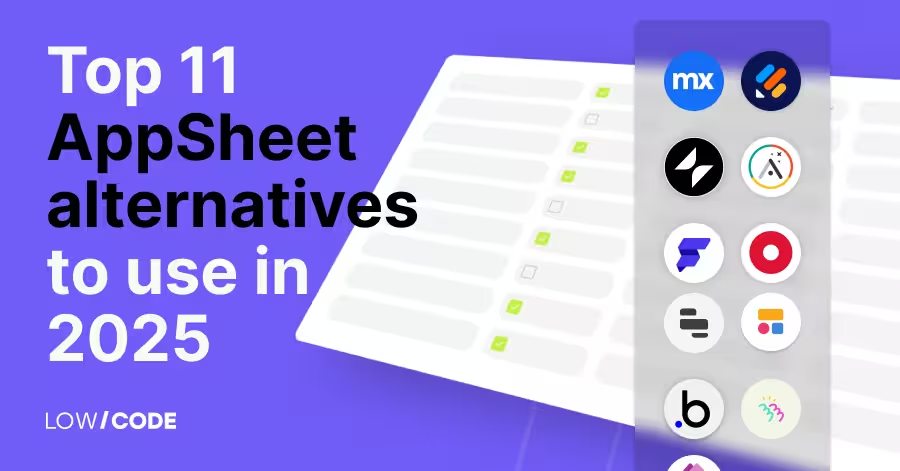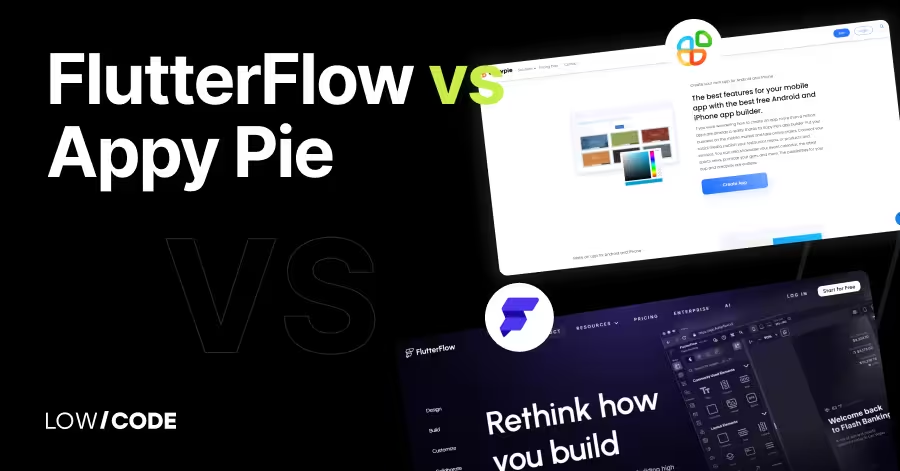WeWeb alternatives: Top 9 picks for every use case
6 min
read
Explore our top choices of WeWeb alternatives along with tips to choose the best no-code platform to fit your project

Are you building a web application or a Progressive Web App (PWA) with no code? WeWeb is a popular choice, offering flexibility and robust features for web development. However, with numerous other platforms available, you might wonder if WeWeb is the best option for your project.
Exploring and comparing different platforms is essential to find the one that fits your needs perfectly. We’ll help you navigate through WeWeb’s strengths and weaknesses, along with introducing you to some top alternatives you can consider.
TL;DR
WeWeb is a powerful no-code platform, but alternatives offer unique strengths. Bubble and Adalo excel in API integration, Backendless provides robust backend services, and FlutterFlow and Webflow offer exceptional design flexibility. For enterprise-grade apps, consider Glide or OutSystems. Webflow is great for static websites, while FlutterFlow and Adalo are ideal for native mobile app development.
| API Integration | Design flexibility | Native mobile app | Code export | Ease of use | |
|---|---|---|---|---|---|
| WeWeb | ★★★ | ★★★ | No | No | Easy |
| Bubble | ★★★★ | ★★★★★ | No | No | Moderate |
| Adalo | ★★★ | ★★★ | Yes | No | Easy |
| FlutterFlow | ★★★★★ | ★★★★★ | Yes | Yes | Easy |
| Webflow | ★★★ | ★★★★ | No | No | Moderate |
| Glide | ★★★★★ | ★★★★ | No | No | Easy |
| OutSystems | ★★★★★ | ★★★ | No | Yes | Moderate |
| Appian | ★★★ | ★★ | No | Yes | Moderate |
Why look for WeWeb alternatives?
While WeWeb provides a robust platform for building web applications, there are valid reasons why you might seek alternatives. Understanding your project requirements and evaluating different platforms will help you make an informed decision.
To get started, make sure you have a clear understanding of your project requirements, including:
- Core functionalities and the desired user experience.
- Team’s technical skillset and development preferences.
- Budget constraints
- Long-term scalability needs.
Let’s outline the essential steps you should take:
- Assess your project needs: Identify the core features, the user experience you aim to create, and any specific technical requirements.
- Research platforms: Look into various platforms that align with your project needs. Read reviews, compare pricing, and consider community support.
- Evaluate their capabilities: Ensure the platform offers the necessary customization, integration capabilities, and scalability options.
- Consider your long-term goals: Think about the future development potential, maintenance, and overall sustainability of the platform.
Key features to consider in an alternative
Having a firm grasp of your project needs simplifies the process of assessing available platforms. Match your priority features and capabilities with what each platform offers. Does the platform tick all the crucial boxes without unnecessary extras?
Ease of use
- Intuitive and user-friendly: Ensure the platform is easy to navigate and use.
- Learning curve: Consider how long it takes to learn the platform and build basic functionalities.
- Support and community: Check if there’s comprehensive documentation, tutorials, and a strong community for assistance.
Flexibility
- Customization options: Look for pre-built components and templates for rapid development, and the ability to heavily customize the UI and functionalities.
- Integration support: Verify if the platform supports integrations with popular APIs and services.
Performance and security
- Optimal performance: Ensure the platform can handle your app’s complexity and provide a seamless user experience.
- Robust security: Check for security features that protect user data and app integrity.
Top alternatives to WeWeb
Finding alternatives with similar features
While WeWeb has proven to be a powerful no-code platform, you may be seeking alternatives that better suit your needs. Here are some similar options we think are worth exploring.
If you like WeWeb for its custom backend through API
Some no-code platforms limit the backend service options; they provide a fixed set of integrations with pre-built connectors. These platforms restrict users to a specific range of external services and databases. Platforms like WeWeb allow you to choose from a broader range of backend services by offering custom API integration capabilities. You get the flexibility to connect your application with any external service or database. However, note that setting up custom integrations may require technical knowledge or assistance from a developer.
Alternatives:
- Bubble: Just like WeWeb, Bubble offers robust API integration, enabling you to create complex applications without touching code. It’s perfect for projects that require extensive backend customization, giving you the flexibility to connect with almost any external service.
- Adalo: Another strong contender, Adalo supports API integrations and excels at building mobile and web apps quickly. It's user-friendly and allows you to incorporate custom backend functionalities seamlessly.
- Backendless: Known for its powerful backend-as-a-service (BaaS) capabilities, Backendless provides extensive API integration options, enabling you to build complex, scalable applications with ease.
Related: Bubble vs Weweb
If you appreciate WeWeb for its design flexibility
Design flexibility allows you to create visually appealing and highly functional interfaces that can be tailored to your specific needs. You can offer a great user experience and make your application stand out.
Alternatives:
- FlutterFlow: FlutterFlow offers exceptional design flexibility, allowing you to create stunning, responsive interfaces for both web and mobile apps. Its drag-and-drop editor and wide range of customizable components make it a fantastic choice for designers.
- Bubble: Bubble not only excels in backend customization but also provides extensive design tools. You can create complex UI elements and workflows, ensuring your app looks and performs exactly as you envision.
- Webflow: If your focus is on web design, Webflow is unmatched in its design capabilities. It allows for pixel-perfect design control and seamless interactions, making it ideal for creating professional, custom websites without code.
Related: Flutterflow vs Weweb
If you need an enterprise-grade app
For larger organizations and enterprises, the need for a robust, secure, and scalable no-code platform to build internal tools and applications is paramount. While WeWeb offers powerful capabilities, some alternatives may better cater to the specific needs of enterprise-level projects.
Alternatives:
- Glide: Glide's ability to integrate with various data sources and its scalable architecture enables it to handle complex enterprise use cases. It offers features such as advanced data integration, workflow automation, and enterprise-grade security and compliance.
- Mendix: As a high-productivity low-code platform, Mendix empowers enterprises to rapidly build, integrate, and deploy applications across web and mobile platforms. Its strong governance and lifecycle management capabilities make it suitable for mission-critical internal tools that require stringent security and scalability.
- OutSystems: OutSystems is an enterprise-grade low-code platform with advanced one-click deployment capabilities, coupled with built-in monitoring and analytics tools. A very good choice for developing and managing large-scale internal applications within an enterprise environment.
Alternatives for different needs
Sometimes, you might realize that your project needs are different from what WeWeb offers. Here are some alternatives based on distinct requirements:
If you need a static website
While platforms that build dynamic websites are great for complex applications that require frequent updates and interactivity, they can be overkill for simpler websites that don't change often. Static websites are faster and easier to maintain than dynamic sites. They’re perfect for showcasing portfolios, company websites, or any other content-first use case.
Alternatives:
- Webflow: Webflow shines when it comes to building beautiful, static websites. Its design tools and hosting services are top-notch, ensuring your site is fast, secure, and easy to manage.
- Wix: Wix is a user-friendly platform that also provides hosting services, so you can publish your site online easily. With Wix, you can choose from a variety of templates and customize them to fit your needs. It’s not as sophisticated as Webflow, but it’s a good option for creating websites that look professional and are easy to maintain.
If you need native mobile app development
Native apps offer access to device features and a better user experience compared to web-based applications. They are ideal for apps that need to run smoothly on iOS and Android devices, and if you want to reach users through their app stores.
Alternatives:
- FlutterFlow: FlutterFlow is an excellent choice for native app development, enabling you to create high-performance mobile apps for both iOS and Android. It uses Google’s Flutter framework, which is known for its speed and efficiency.
- Adalo: Adalo also supports native mobile app development, providing an easy-to-use platform for building and launching apps quickly. It’s perfect for entrepreneurs and small businesses looking to develop mobile apps without coding.
If you want to be able to export your code
If you want to be able to export your code and have full control over the codebase for your web or mobile application, platforms like WeWeb that follow a true no-code approach may not be the best fit. In such cases, you may want to consider alternatives.
Exporting code refers to the ability to access, modify, and work with the underlying source code of your application outside of the platform's visual development environment. This level of control can be beneficial for advanced customization, integration with existing codebases, or situations where you need to self-host or deploy your application on-premises.
Alternatives:
- Flutterflow: Flutterflow is a low-code platform that allows you to build cross-platform mobile applications using Google's Flutter framework. While it offers a visual development environment, Flutterflow also provides the ability to export the complete source code for your Flutter app, giving you full control over customization and deployment.
- Appian: Although primarily an enterprise low-code platform, Appian offers the option to export the source code for applications built on its platform. This can be useful for organizations that require on-premise deployment or need to integrate their applications with existing codebases and systems.
Conclusion
As a leading no-code agency, we’ve explored many platforms, each with its strengths and downsides. WeWeb is a powerful tool for web development, but exploring alternatives can open up new possibilities for your project. Ultimately, the best fit will depend on your specific needs for features, flexibility, and future scalability. Thoroughly assess your priorities to make an informed decision that aligns with your project goals.
If you’re unsure which platform is the best fit, we’re here to help. Share your project details with us, and our experts will guide you in choosing the right platform and building your app.
Did you find this content helpful? Book a free discovery call and we'll help you decide which is the best tool for your project.
Created on
June 16, 2024
. Last updated on
May 7, 2025
.

FAQs
Is WeWeb better than Bubble?
Can WeWeb export code?
Which no-code platform is better?
Does WeWeb offer a free trial?








%20(Custom).avif)








